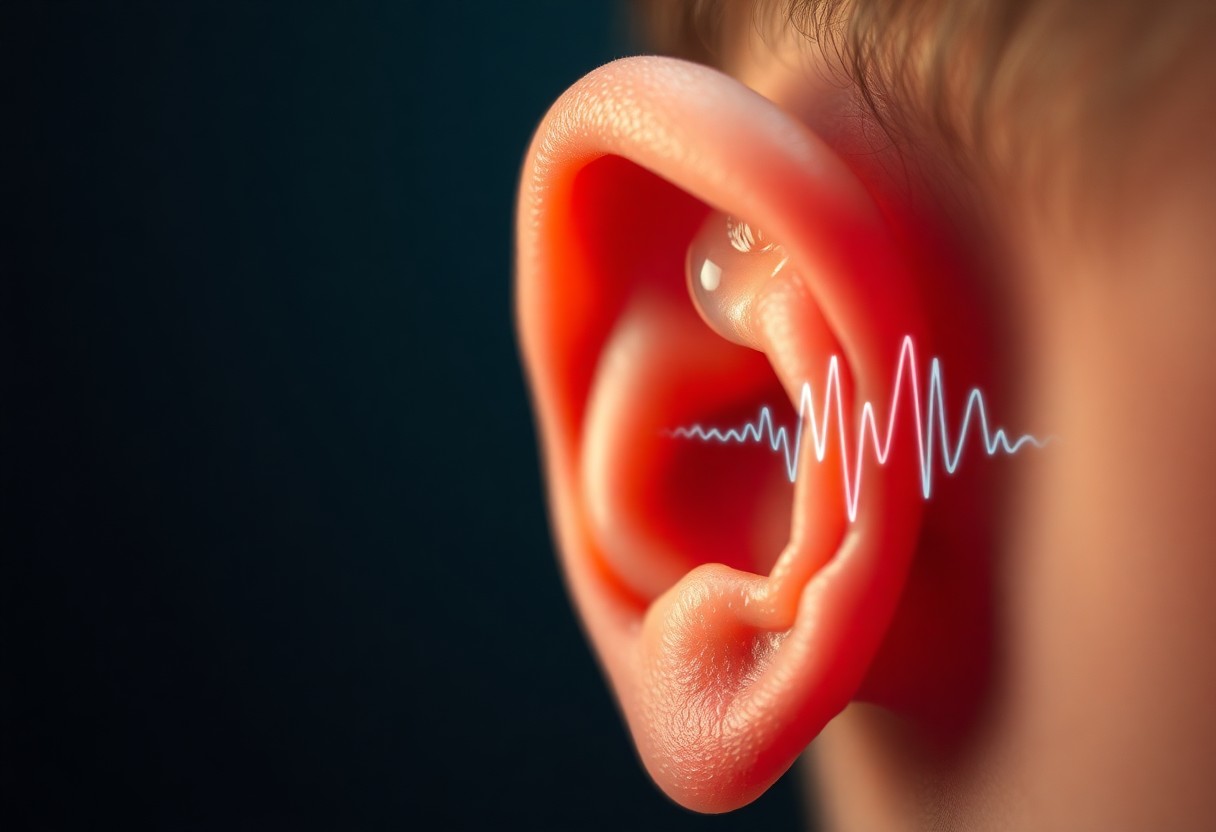There’s a significant link between excess cerumen buildup and the clarity of microphonic responses in your auditory system. When earwax accumulates, it can hinder sound transmission, affecting your ability to hear clearly. This post will explore into how excessive earwax impacts your auditory perception and offers insights into maintaining optimal ear health for improved sound quality.

Key Takeaways:
- Excess cerumen can obstruct the ear canal, leading to reduced sound transmission and clarity.
- The presence of cerumen alters the acoustic properties, affecting the quality of microphonic signals.
- Regular ear hygiene is important to maintain optimal hearing function and prevent interference from cerumen buildup.
The Role of Cerumen in Auditory Health
Natural Functions of Earwax
Cerumen serves several protective and maintenance functions in your auditory system. It acts as a natural barrier, trapping dust, debris, and microorganisms, thus preventing them from reaching the sensitive structures of the ear. Additionally, earwax has lubricating properties that promote the health of the ear canal skin and can help reduce irritation caused by sound exposure and fluctuations in humidity. This self-cleaning property assists in the natural expulsion of unwanted particles from your ears.
The Composition and Properties of Cerumen
Cerumen is a complex mixture primarily composed of fatty acids, alcohols, cholesterol, and various proteins. Its unique composition makes earwax both waterproof and slightly acidic, creating an inhospitable environment for bacteria and fungi. This specificity in its formulation not only aids in safeguarding your ears from infections but also ensures earwax remains pliable enough to move debris out of the auditory canal. Understanding the intricate balance of these components helps in appreciating the important role cerumen plays in maintaining auditory health.
The variety of cerumen types—wet and dry—results from genetic variations. Wet cerumen, prevalent among individuals of African and European descent, contains a higher lipid content, while dry cerumen, common in East Asian populations, appears flakier and less oily. This genetic trait also affects the earwax’s ability to trap and expel debris. The production rate of cerumen can vary greatly among individuals, influenced by factors such as age, environmental conditions, and individual health, highlighting the dynamic nature of this important substance. Awareness of these aspects contributes to a broader understanding of your ear health and the significance of maintaining optimal cerumen levels.

When Cerumen Becomes Excessive: Causes and Implications
Factors Leading to Excessive Cerumen Production
Several factors can contribute to the overproduction of cerumen in your ears. Genetic predisposition may play a significant role, as some people naturally produce more earwax than others. Additionally, certain skin conditions, such as eczema or dermatitis, can stimulate increased earwax production, while aging might lead to dry or hardened cerumen buildup. Environmental factors, like humidity and exposure to allergens, can also impact earwax consistency and volume.
- Genetic predisposition
- Skin conditions (eczema, dermatitis)
- Aging-related changes
- Environmental factors (humidity, allergens)
Knowing these factors can help you understand your own ear health and any potential issues related to excessive cerumen production.
Environmental and Behavioral Influences
Your environment and personal habits significantly influence cerumen production and management. Frequent use of cotton swabs can push earwax further into the ear canal, while exposure to dust, water, and humidity can cause earwax to become more liquid and prone to buildup. Additionally, behavior such as swimming increases moisture, which may encourage the ear to produce more cerumen as a protective response.
Occupational exposure to pollutants, allergens, or irritants can similarly enhance cerumen production. For example, jobs that require you to wear ear protection or headsets often can lead to increased irritation and thus more wax buildup. Active participation in water sports or hobbies involving dirt and debris further complicates the situation, as your body attempts to safeguard your hearing with more wax. Adjusting your routine or environment may be necessary for maintaining auditory health.
Microphonic Clarity: What It Is and Why It Matters
Understanding Microphonics in Hearing
Microphonics refer to the ability of a hearing device or auditory system to pick up and amplify sound signals accurately. This involves converting sound waves into electrical signals that can be processed by the brain. When your ear functions optimally, it allows for nuanced sound quality and detailed auditory experiences, enabling you to distinguish between different instruments in a symphony or hold a conversation in a crowded room.
The Importance of Clarity in Sound Perception
Clarity in sound perception is vital for effective communication and environmental awareness. A clear sound signal enhances your ability to engage in conversations, enjoy music, and respond to your surroundings. Without this clarity, sounds may blend into one another, leading to misunderstandings and a reduced quality of life.
Studies show that individuals with compromised auditory clarity, often due to excessive cerumen, experience difficulties in social situations, feel isolated, and may report diminished enjoyment in musical activities. In fact, research has indicated that up to 60% of people with hearing loss cite clarity as a leading challenge in daily interactions. Achieving microphonic clarity not only enriches auditory experiences but also significantly bolsters overall well-being by fostering social connections and facilitating communication.
How Excess Cerumen Disrupts Microphonic Clarity
The Physical Blockage Effect
Excess cerumen creates a physical barrier in your ear canal, obstructing sound waves from reaching your eardrum. This blockage dampens the transmission of sound, often resulting in muffled hearing or a sensation of fullness in your ears. When the ear canal is obstructed, the natural movement of sound becomes restricted, significantly affecting the clarity of sounds that reach your inner ear.
Acoustic Properties Altered by Cerumen
Beyond merely blocking sound, cerumen alters its acoustic properties, including frequency response and sound pressure levels. Different types of cerumen, whether wet or dry, can manipulate how sound waves are filtered and perceived in your auditory system. For instance, firmer, denser cerumen may attenuate higher frequencies more than lower ones, leading to a skewed sound perception, where clarity significantly diminishes.
This alteration occurs because cerumen can absorb or dampen specific frequency ranges. For example, if you have a buildup of wet cerumen, the additional mass can lower the overall resonance frequency of your ear canal. This means that sounds in higher ranges may sound less prominent, while lower tones may appear exaggerated, ultimately compromising the precise balance needed for clear amplification in hearing devices and everyday sound perception.
Diagnosing Cerumen-Related Hearing Issues
Symptoms of Excess Earwax Build-Up
Common symptoms of excess earwax build-up include muffled hearing, earache, a sensation of fullness in the ear, tinnitus (ringing in the ear), and sometimes dizziness. If you experience a sudden change in hearing clarity or discomfort, it may indicate a more significant blockage. Regularly monitoring these symptoms can help you address any potential issues before they escalate.
Audiological Tests to Measure Clarity
Audiological tests are imperative in assessing the impact of earwax on your hearing. These tests might include pure-tone audiometry and tympanometry, which can help distinguish between conductive hearing loss caused by significant cerumen build-up and other auditory issues.
Pure-tone audiometry involves listening to a series of tones at varying frequencies to determine your hearing thresholds. If cerumen impairs your ability to hear these tones clearly, the results will indicate conductive hearing loss. Tympanometry tests the movement of the eardrum in response to pressure changes, revealing how earwax affects eardrum function. Both tests provide valuable insights that guide treatment and intervention strategies for restoring auditory clarity.
Practical Solutions for Managing Excess Cerumen
Professional Cleaning Techniques
Consulting a healthcare professional for cerumen removal ensures safety and effectiveness. Techniques like suctioning, curettage, or irrigation allow for precise removal of stubborn earwax. These methods are typically done in a clinical setting, minimizing potential damage to your ear canal. A healthcare provider can also evaluate the severity of the build-up and provide personalized advice on prevention.
Home Remedies and Prevention Strategies
Simple home remedies can assist in managing excess cerumen and preventing future build-up. Regularly using a few drops of mineral oil or hydrogen peroxide can help soften earwax, making it easier to expel. You might also consider using a warm cloth to clean around the ear, avoiding any invasive instruments that could push wax further inside.
Incorporating preventive measures into your routine can reduce earwax accumulation. Maintain a consistent ear hygiene schedule by gently cleaning your outer ear with a damp cloth. Cerumen should not be removed with cotton swabs, which often push wax deeper. Instead, consider incorporating irrigation solutions or seeking professional check-ups if you’re prone to excess wax. Utilizing earplugs when swimming can also help reduce moisture, preventing earwax from hardening while protecting your ears from debris and infections.
The Interplay Between Cerumen and Hearing Instruments
How Hearing Aids Are Affected by Earwax
Excess earwax can significantly impair the performance of hearing aids by blocking speakers and microphones. This obstruction can result in distorted sound and decreased amplification, making it challenging for you to hear clearly. Some hearing aids are designed to resist earwax intrusion, yet even these can be affected if earwax builds up excessively.
Maintenance Tips for Optimal Functionality
Regular maintenance of your hearing aids is important for ensuring optimal functionality. Cleaning them weekly with a soft, dry cloth can help prevent earwax accumulation. Additionally, consider using a hearing aid dehumidifier to minimize moisture, which can also trap earwax. Routine checks for blockage will ensure that your devices perform at their best.
- Clean your hearing aids weekly with a soft, dry cloth.
- Use a hearing aid dehumidifier regularly to reduce moisture.
- Schedule professional cleanings every six months.
- Assume that neglecting this maintenance can lead to significant performance issues.
Incorporating daily habits like removing earwax with a soft, damp cloth around your ears can further enhance the life of your hearing aids. Avoid inserting objects into your ears to prevent pushing earwax deeper. Regularly inspect your devices for signs of wax buildup to catch any issues early on.
- Adopt a daily cleaning routine for your ears, using only a damp cloth.
- Check your hearing aids daily to spot potential wax buildup.
- Store devices in a protective case when not in use.
- Assume that proactive care will prolong the longevity of your hearing instruments.
Shifting the Narrative: Re-evaluating Earwax
Debunking Myths Surrounding Cerumen
Cerumen, or earwax, often gets a bad reputation as a nuisance or an indication of poor hygiene. Many believe that its presence always signifies neglect or uncleanliness. In reality, earwax serves vital functions, such as trapping dust and debris while maintaining moisture in the ear canal. Misconceptions can lead to unnecessary interventions that may disrupt this natural defense mechanism, sometimes exacerbating ear issues rather than alleviating them.
Understanding the Balance Between Hygiene and Health
Finding the right equilibrium between maintaining ear hygiene and supporting health is vital. Over-cleaning the ears can strip away natural cerumen, leading to an increase in infections and irritation. Conversely, allowing excessive build-up can impair hearing and introduce complications. The key lies in recognizing that cerumen plays a protective role while managing hygiene practices that promote, rather than inhibit, ear health.
The ear functions best when cerumen levels remain optimal; too little can lead to dryness and vulnerability to infection, while too much can obstruct sound transmission. Regular cleaning with a soft cloth on the outer ear is sufficient for most individuals. It’s advisable to consult with a professional for wax removal instead of resorting to cotton swabs, which can push wax deeper and cause blockages. This mindful approach helps you support natural ear health while avoiding the pitfalls of excessive cleaning or neglect.
Conclusion
From above, you can see that excess cerumen can significantly interfere with microphonic clarity by creating a barrier that dampens sound transmission and alters auditory perception. If you experience reduced hearing or muffled sounds, it may be due to the accumulation of earwax. Regular ear hygiene and consultations with healthcare professionals can help ensure your auditory system remains clear, allowing you to enjoy optimal hearing function.
FAQ
Q: How does excess cerumen affect hearing ability?
A: Excess cerumen can block the ear canal, leading to reduced sound transmission and muffled hearing, making it difficult to discern speech and other important sounds.
Q: What is microphonic clarity?
A: Microphonic clarity refers to the clarity and intelligibility of sound perception in the ear, which is imperative for accurately hearing voices and environmental sounds.
Q: Can excess cerumen cause ear infections?
A: Yes, excess cerumen can trap moisture and debris in the ear canal, creating an environment conducive to bacterial growth, leading to ear infections.
Q: How can one safely remove excess cerumen?
A: It is recommended to consult a healthcare professional for ear cleaning. They may use tools or suction methods to safely remove cerumen without causing damage to the ear canal.
Q: What are the signs of excessive cerumen buildup?
A: Signs include muffled hearing, earache, a feeling of fullness in the ear, tinnitus (ringing in the ear), and occasional dizziness.



